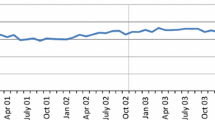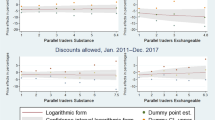Abstract
In this paper we investigate the implications of permitting parallel imports of pharmaceuticals produced by a monopoly, from one country to another. We use a model where countries differ in the patients’ level of co-payment for buying pharmaceuticals, and patients differ in the utility obtained from the consumption of pharmaceuticals. We show that the effects of parallel imports on total welfare are as follows: On the one hand, when countries differ in their health system only, parallel imports decrease total welfare; On the other hand, when countries differ in the health needs of their patients only, parallel imports enhance total welfare.
Similar content being viewed by others
References
Danzon, P. M. (1998). “The Economics of Parallel Trade.”PharmacoEconomics 13(3), 293–304.
Ganslandt, M. and K. E. Maskus. (2001). “Parallel Imports ofPharmaceutical Products in the European Union.”Working paper No. 546. The research institute of industrial economics (Stockholm).
Hausman, J. A. and J. K. MacKie-Mason (1988). “Price Discrimination and Patent Policy.”RAND Journal of Economics19(2), 253–265.
Jelovac, I (2002). “On the Relationship Between the Negotiated Prices of Pharmaceuticals and the Patients’ Co-Payment.”Working paper 0208. Center for Economic Development. Hong Kong University of Science and Technology.
Jelovac, I (2004). “Monopolistic Third-Degree Price Discrimination of Subsidized Goods.”Mimeo.
Malueg, D. A. and M. Schwartz (1994). “Parallel Imports, Demand Dispersion, and International Price Discrimination.”Journal of International Economics 37, 167–195.
Maskus, K. E (2000). “Parallel Imports.”World Economy 23(9), 1269–1284.
Maskus, K. E (2001). “Parallel Imports in Pharmaceuticals: Implications for Competition and Prices in Developing Countries.”Final Report to the World Intellectual Property Organization.
Maskus, K. E. and Y. Chen (2002). “Parallel Imports in a Model of Vertical Distribution: Theory, Evidence and Policy.”Pacific Economic Review 7(2), 319–334.
Pavcnik, N (2002). “Do Pharmaceutical Prices Respond to Potential Patient Out-of-Pocket Expenses?”RAND Journal Economics 33(3), 469–487.
Pecorino, P (2002). “Should the US Allow Prescription Drug Reimports from Canada?”Journal of Health Economics 796, 1–10.
Richardson, M (2002). “An Elementary Proposition Concerning Parallel Imports.”Journal of International Economics 56, 233–245.
Robinson, J (1933). Economics of Imperfect Competition. London: Macmillan.
Schmalensee, R (1981). “Output and Welfare Implications of Monopolistic Third-Degree Price Discrimination.”American Economic Review 71, 242–247.
Author information
Authors and Affiliations
Corresponding author
Rights and permissions
About this article
Cite this article
Jelovac, I., Bordoy, C. Pricing and Welfare Implications of Parallel Imports in the Pharmaceutical Industry. Int J Health Care Finance Econ 5, 5–21 (2005). https://doi.org/10.1007/s10754-005-6599-x
Issue Date:
DOI: https://doi.org/10.1007/s10754-005-6599-x




